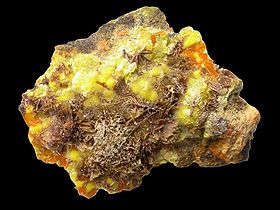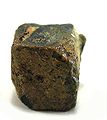- Rutherfordine
-
Rutherfordine
Catégorie V : carbonates et nitrates[1]
Rutherfordine brune foncée, uranophane jaune et billietite orange, Sinkolobwe Mine, Congo, 2.5 x 2.0 x 0.7 cm. Général Classe de Strunz 5.EB.05 Formule brute U6+O2+2(CO2-3) Identification Masse formulaire 330.04 uma Couleur blanc, jaune, jaune pâle, ambré orange, brunâtre, vert jaunâtre, blanc jaunâtre, jaune brunâtre Classe cristalline et groupe d'espace Dipyramidale; Imm2 Système cristallin Orthorhombique Réseau de Bravais Primitif P Clivage Parfait à {010}, distinct à {001} Habitus Agrégats, fibroradié, en croûte, aciculaire, en rosettes, laminaire, microscopique Trait Jaune Éclat Mat, soyeux Propriétés optiques Indice de réfraction a=1.7-1.723, b=1.716-1.73, g=1.755-1.795 Pléochroïsme x: incolore, y: jaune pâle, z: jaune verdâtre pâle Biréfringence Biaxial(+); 0.0550-0.0720 Dispersion 2vz ~ 53 Fluorescence ultraviolet Jaune-vert Transparence Transparent à translucide Propriétés chimiques Densité 5.7 Solubilité Soluble dans les acides Propriétés physiques Magnétisme Aucun Radioactivité 129,098 Bq/g Unités du SI & CNTP, sauf indication contraire. La rutherfordine est une espèce minérale du groupe des carbonates et du sous-groupe des carbonates d'uranyle, de formule, U6+O2+2(CO2-3).
Sommaire
Inventeur et étymologie
La rutherfordine a été décrite en 1906 par Marckwald; elle fut nommée ainsi en l'honneur d'Ernest Rutherford, physicien atomiste britannique, prix nobel de chimie 1908.
Topotype
- U-bearing pegmatite, Morogoro, Uluguru Mts (Uruguru Mts), Morogoro Region, Tanzanie[2].
- Les échantillons de référence sont déposés au muséum d'histoire naturelle de Paris ainsi qu'au National Museum of Natural History de Washington.
Cristallographie
- Paramètres de la maille conventionnelle: a=4,845 Å, b=9,205 Å, c=4,296 Å, Z=2, V=191,59 Å3
- Densité(Calc)= 5.72
Cristallochimie
- La rutherfordine fait partie du groupe de la joliotite
Groupe de la joliotite
- Blatonite (UO2+2)CO2-3,H2O, Unk; Hexa
- Joliotite (UO2+2)CO2-3,nH2O,(n=2?) P 222, Pmm2; Ortho
- Oswaldpeetersite (UO2+2)2CO2-3(OH)2,4H2O, P 21/c; 2/m
- Rutherfordine (UO2+2)CO2-3, P mmm; 2/m 2/m 2/m
Gîtologie
La rutherfordine est un minéral secondaire d'altération de l'uraninite.
Minéraux associés
- Uraninite, becquerelite, masuyite, schoepite, kasolite, curite, boltwoodite, vandendriesscheite, billietite, metatorbernite, fourmarierite, studtite, sklodowskite, baryte,chalcopyrite, pyrite, torbernite, uranophane.
Habitus
La rutherfordine prend surtout la forme de lattes orthorhombiques allongées pouvant atteindre 3 mm et plus. Elle peut former des agrégats radiés, fibreux, enchevêtrés ou des masses pulvérulentes. La formation de rosettes ouvertes est fréquente, mais non des nodules.
Synonymie
- Diderichite (J.F. Vaes): Initalement dédiée au géologue belge Norbert Diderich[3].
Gisements remarquables
- Congo
- Shinkolobwe Mine (Kasolo Mine), Shinkolobwe, Central area, Katanga Copper Crescent, Katanga (Shaba).
- États-Unis
- Dunton Gem Quarry, Newry, Oxford Co., Maine[4]
- France
- Liauzun, Olloix, Saint-Amant-Tallende, Puy-de-Dôme, Auvergne[5]
- Riviéral/Mas d'Alary-Village, Lodève, Hérault, Languedoc-Roussillon[5]
- Les Pradels Ravine, St Léger-de-Peyre, Marvejols, Lozère, Languedoc-Roussillon[5]
- La Dorgissière Mine, Saint-Amand-sur-Sèvre, Deux-Sèvres, Poitou-Charentes[6]
- Bel Air Mine, La Chapelle Largeau, Deux-Sèvres, Poitou-Charentes[6]
- Grande-Bretagne
- Poitou-Charentes, Botallack, Botallack - Pendeen Area, St Just District, Cornwall, Angleterre[7]
- Tanzanie
- U-bearing pegmatite, Morogoro, Uluguru Mts (Uruguru Mts), Morogoro Region[2]
Galerie
-
Rutherfordine sur uraninite, Morogoro, Tanzanie, 0.9 x 0.8 x 0.7 cm
Notes et références
- La classification des minéraux choisie est celle de Strunz.
- Centr.Min.(1906) p. 761-764; J. Geffroy, J.A. Sarcia, J. Chervet : "Les Minéraux Uranifères Français", 1960, Institut National des Sciences et Techniques Nucléaires / Saclay - PUF.
- Ann. Soc. Belg., t70 1946-1947 p.B. 224
- King, V. and Foord, E., 1994, Mineralogy of Maine, V. 1; King, V. (ed), 2000, Mineralogy of Maine, V. 2.
- Le Règne Minéral, Hors Série IV (1998)
- Le Cahier des micromonteurs, 2002, N°75, pp 8-25
- [Journal of the Russell Society, 6(1), 17-26 (1995)]
- Marckwald (1906) Centralblatt für Mineralogie, Geologie und Paleontologie, Stuttgart: 761.
- Larsen, E.S. (1921) The Microscopic Determination of the Nonopaque Minerals, First edition, USGS Bulletin 679: 129.
- Palache, C., Berman, H., & Frondel, C. (1951), The System of Mineralogy of James Dwight Dana and Edward Salisbury Dana, Yale University 1837-1892, Volume II: Halides, Nitrates, Borates, Carbonates, Sulfates, Phosphates, Arsenates, Tungstates, Molybdates, Etc. John Wiley and Sons, Inc., New York, 7th edition, revised and enlarged: 274-275.
- Frondel, C. and R. Meyerowitz (1956) Studies of uranium minerals (XIX): rutherfordine, diderichite, and clarkeite. Amer. Mineral., 41, 127–133.
- Clark, J.R. and C.L. Christ (1956) Some observations on rutherfordine. Amer. Mineral., 41, 844–850.
- Finch, R.J., M.A. Cooper, and F.C. Hawthorne (1999) Refinement of the crystal structure of
rutherfordine. Can. Mineral., 37, 929–938.
- Kubatko, Karrie-Ann, Katheryn Helean, Alexandra Navrotsky, and Peter C. Burns (2005), Thermodynamics of uranyl minerals: Enthalpies of formation of rutherfordine, UO2CO3, andersonite, Na2CaUO2(CO3)3(H2O)5, and grimselite, K3NaUO2(CO3)3H2O: American Mineralogist: 90: 1284-1290.
- Burns, P.C. (2005) U 6+ minerals and inorganic compounds: insights into an expanded structural hierarchy of crystal structures. Canadian Mineralogist: 43: 1839-1894.
- Portail des minéraux et roches
- Portail de la chimie
Wikimedia Foundation. 2010.




